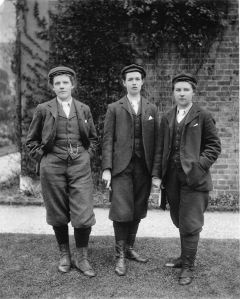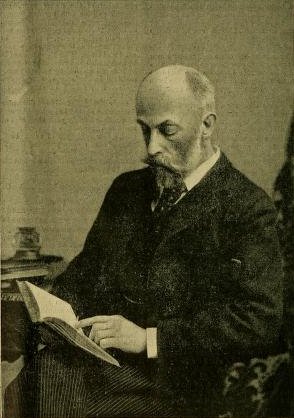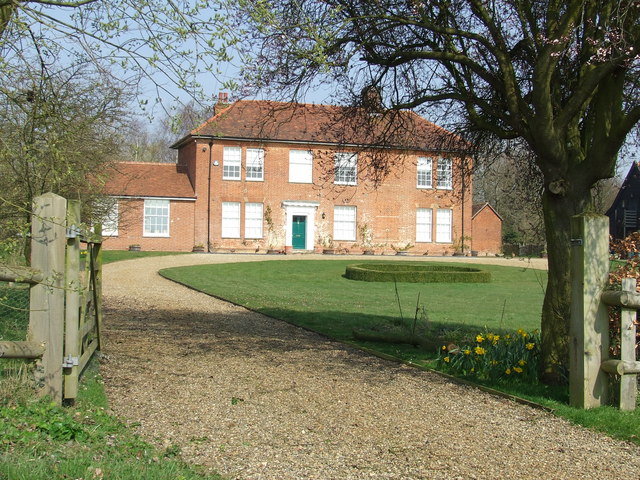|
Annie Gulvin
Annie M Gulvin (18 June 1876 - 1972) was one of the first two women gardeners at the Royal Botanic Gardens, Kew. Early life and education Annie Gulvin was born Mary Ann Gulvin in 1876, the daughter of Charles Gulvin, a police constable, and Mary Ann Hooker. She was one of the first female students at the previously all-male Swanley Horticultural College, and graduated top of her class. The Royal Horticultural Society published rankings of its examinees, and in 1895 Gulvin placed first and won their Silver Gilt Medal. Career In January 1896 Gulvin was appointed, with Alice Hutchins, by William Thiselton-Dyer, then Director of the Royal Botanic Gardens as the first women gardeners at Kew. Gulvin and Hutchins were then joined by Gertrude Cope and Eleanor Morland. The women were employed on equal pay, and were made to wear the same brown woolen uniform as male gardeners, so as not to distract their male colleagues. However, due to the publicity this caused, skirts were t ... [...More Info...] [...Related Items...] OR: [Wikipedia] [Google] [Baidu] |
Royal Botanic Gardens, Kew
Royal Botanic Gardens, Kew is a non-departmental public body in the United Kingdom sponsored by the Department for Environment, Food and Rural Affairs. An internationally important botanical research and education institution, it employs 1,100 staff. Its board of trustees is chaired by Dame Amelia Fawcett. The organisation manages botanic gardens at Kew in Richmond upon Thames in south-west London, and at Wakehurst, a National Trust property in Sussex which is home to the internationally important Millennium Seed Bank, whose scientists work with partner organisations in more than 95 countries. Kew, jointly with the Forestry Commission, founded Bedgebury National Pinetum in Kent in 1923, specialising in growing conifers. In 1994, the Castle Howard Arboretum Trust, which runs the Yorkshire Arboretum, was formed as a partnership between Kew and the Castle Howard Estate. In 2019, the organisation had 2,316,699 public visitors at Kew, and 312,813 at Wakehurst. Its site at Kew ... [...More Info...] [...Related Items...] OR: [Wikipedia] [Google] [Baidu] |
Swanley Horticultural College
Swanley Horticultural College, founded in , was a college of horticulture in Hextable, Kent, England. It originally took only male students but by 1894 the majority of students were female and it became a women-only institution in 1903. Early history The college was registered as The Horticultural College and Produce Company, Limited on 30 January 1889. Businessman Arthur Harper Bond (1853–1940) described how he had wished to "do something in the way of applying scientific principles to fruit-growing" and met a man who offered "his" property at Swanley as its base. Bond occupied the property to set up "the Horticultural College", but it later transpired that the property belonged to naval architect and politician Edward Reed. Bond bought it from Reed as "the only way to extricate myself from a difficult position and save my pet scheme from extinction". The college's lecture theatre was the saloon designed by Reed for SS ''Bessemer'', which had been built to swing on gimbals in ... [...More Info...] [...Related Items...] OR: [Wikipedia] [Google] [Baidu] |
Royal Horticultural Society
The Royal Horticultural Society (RHS), founded in 1804 as the Horticultural Society of London, is the UK's leading gardening charity. The RHS promotes horticulture through its five gardens at Wisley (Surrey), Hyde Hall (Essex), Harlow Carr (North Yorkshire), Rosemoor (Devon) and Bridgewater (Greater Manchester); flower shows including the Chelsea Flower Show, Hampton Court Palace Flower Show, Tatton Park Flower Show and Cardiff Flower Show; community gardening schemes; Britain in Bloom and a vast educational programme. It also supports training for professional and amateur gardeners. the president was Keith Weed and the director general was Sue Biggs CBE. History Founders The creation of a British horticultural society was suggested by John Wedgwood (son of Josiah Wedgwood) in 1800. His aims were fairly modest: he wanted to hold regular meetings, allowing the society's members the opportunity to present papers on their horticultural activities and discoveries, to enc ... [...More Info...] [...Related Items...] OR: [Wikipedia] [Google] [Baidu] |
Alice Hutchins (gardener)
Alice Hutchins (c. 1870 – 24 January 1944) was one of the two first women gardeners hired at Kew Gardens in 1896. Education Hutchins trained at the Horticultural College for Women at Swanley in Kent after it began accepting women in 1891. Her studies were funded by a Kent County Council Scholarship. She received a College Diploma after the two-year program. Kew Gardens In 1896, she and Annie Gulvin were the first women hired by Director William Thiselton-Dyer at Kew Gardens as "improvers". They received the same salary as male staff. They initially wore the same uniforms as the male garden staff to ensure order and consistency. These bloomers drew media attention and criticism, so they were swapped for skirts. Hutchins worked long hours and performed physical tasks in addition to studying chemistry, botany and horticulture in the evenings. By 1897, she had been promoted to gardener and was responsible for certain houses and frames in the garden. She received top marks ... [...More Info...] [...Related Items...] OR: [Wikipedia] [Google] [Baidu] |
William Thiselton-Dyer
Sir William Turner Thiselton-Dyer (28 July 1843 – 23 December 1928) was a leading British botanist, and the third director of the Royal Botanic Gardens, Kew. Life and career Thiselton-Dyer was born in Westminster, London. He was a son of William George Thiselton-Dyer (1812-1868), physician and Catherine Jane, née Firminger (1815-1897), botanist. He was educated at King's College School where he was first mathematical scholar, and later proceeded to the medical department of King's College London, where he remained until 1863 when he proceeded to Christ Church, Oxford. Initially studying mathematics at Christ Church, Oxford, he graduated in natural science in 1867. He became Professor of Natural History at the Royal Agricultural College in Cirencester and then Professor of Botany at the Royal College of Science for Ireland in Dublin. In 1872, he became professor at the Royal Horticultural Society in London, being recommended by Joseph Dalton Hooker. Then in 1875, Thiselton ... [...More Info...] [...Related Items...] OR: [Wikipedia] [Google] [Baidu] |
Gertrude Cope
Gertrude or Gertrud may refer to: Places In space *Gertrude (crater), a crater on Uranus's moon Titania *710 Gertrud, a minor planet Terrestrial placenames *Gertrude, Arkansas *Gertrude, Washington *Gertrude, West Virginia People *Gertrude (given name), a given name (including a list of people with the name) People with Gertrude as the full name: *Blessed Gertrude of Aldenberg (1227–1297), daughter of Saint Elizabeth of Thuringia and abbess near Trier *Gertrude of Austria (1226–1288), Duchess of Austria and Styria *Gertrude of Babenberg, Duchess of Bohemia, Gertrude of Babenberg (c.1118–1150), Duchess of Bohemia *Gertrude of Baden (c.1160–1225), Margravine of Baden *Gertrude of Bavaria (died 1197), daughter of Henry the Lion, Queen consort of Denmark *Gertrude of Brunswick (c.1060–1117), Margravine of Frisia and Meissen *Gertrude of Comburg (died 1130), Queen consort of Germany *Gertrude of Dagsburg (died 1225), Duchess of Lorraine *Gertrude of Delft (died 1358), Dutch ... [...More Info...] [...Related Items...] OR: [Wikipedia] [Google] [Baidu] |
Eleanor Morland
Eleanor () is a feminine given name, originally from an Old French adaptation of the Old Provençal dialect, Provençal name ''Aliénor''. It is the name of a number of women of royalty and nobility in western Europe during the High Middle Ages. The name was introduced to England by Eleanor of Aquitaine, who came to marry Henry II of England, King Henry II. It was also borne by Eleanor of Provence, who became Queen consort of England as the wife of Henry III of England, King Henry III, and Eleanor of Castile, wife of Edward I. The name was popular in the United States in the 1910s and 1920s, peaking at rank 25 in 1920. It declined below 600 by the 1970s, again rose to rank 32 in the 2010s. Eleanor Roosevelt, the longest-serving first lady of the US was probably the most famous bearer of the name in contemporary history. Common hypocorisms include Elle (name), Elle, Ella (name), Ella, Ellie, Ellie, Elly, Leonor, Leonora (given name), Leonora, Leonore (other), Leonore, Nel ... [...More Info...] [...Related Items...] OR: [Wikipedia] [Google] [Baidu] |
Iscoed
Iscoed, Ferryside, Carmarthenshire, Wales is a ruined eighteenth century mansion attributed to the architect Anthony Keck. Constructed for Sir William Mansel in 1772, it was purchased by the Napoleonic general Sir Thomas Picton as an incomplete shell in 1812. The house remained the property of the Picton family until the end of the First World War. Used subsequently as council housing, it has been empty since the 1950s, and is now a derelict shell. The house is Grade II listed. History The house was constructed for Sir William Mansel in 1772. The design is attributed to Anthony Keck, in part because Keck is known to have worked for the Mansel family elsewhere. Following Mansel's death in 1804, the unfinished shell, and surrounding estate, was bought by General Sir Thomas Picton in 1812. Picton soon regretted the purchase and made plans to sell the house, which were curtailed by his death at the Battle of Waterloo in 1815. The house remained the home of the Pictons until th ... [...More Info...] [...Related Items...] OR: [Wikipedia] [Google] [Baidu] |
Carmarthenshire
Carmarthenshire ( cy, Sir Gaerfyrddin; or informally ') is a county in the south-west of Wales. The three largest towns are Llanelli, Carmarthen and Ammanford. Carmarthen is the county town and administrative centre. The county is known as the "Garden of Wales" and is also home to the National Botanic Garden of Wales. Carmarthenshire has been inhabited since prehistoric times. The county town was founded by the Romans, and the region was part of the Kingdom of Deheubarth in the High Middle Ages. After invasion by the Normans in the 12th and 13th centuries it was subjugated, along with other parts of Wales, by Edward I of England. There was further unrest in the early 15th century, when the Welsh rebelled under Owain Glyndŵr, and during the English Civil War. Carmarthenshire is mainly an agricultural county, apart from the southeastern part which was once heavily industrialised with coal mining, steel-making and tin-plating. In the north of the county, the woollen industr ... [...More Info...] [...Related Items...] OR: [Wikipedia] [Google] [Baidu] |
Burstall, Suffolk
Burstall is a village and civil parish in Suffolk, England. Located around west of Ipswich, it is part of Babergh district. The parish includes the hamlet of Burstallhill. Recorded in the Domesday Book as Burgestala / Burghestala. It is in the Belstead Brook electoral division of Suffolk County Council. The south-western boundary of the parish is delineated by Belstead Brook, a tributary of the River Orwell. The A1071 between Ipswich and Hadleigh crosses Belstead Brook at Burstall Bridge. Burstall Hall is ⅔ mile (1 km) northeast from the village. Mill Farm is to the west and Hill Farm to the east. The village hall built in 1910 in memory of John Cranfield. It is a Mock Tudor building with a recent lottery grant improvements. No alcohol is sold in the hall. The Half Moon public house closed in 1968 and the Post office closed in 2006. St Mary's Church The parish church of St Mary has been a Grade I listed building In the United Kingdom, a listed building o ... [...More Info...] [...Related Items...] OR: [Wikipedia] [Google] [Baidu] |
1876 Births
Events January–March * January 1 ** The Reichsbank opens in Berlin. ** The Bass Brewery Red Triangle becomes the world's first registered trademark symbol. * February 2 – The National League of Professional Base Ball Clubs is formed at a meeting in Chicago; it replaces the National Association of Professional Base Ball Players. Morgan Bulkeley of the Hartford Dark Blues is selected as the league's first president. * February 2 – Third Carlist War – Battle of Montejurra: The new commander General Fernando Primo de Rivera marches on the remaining Carlist stronghold at Estella, where he meets a force of about 1,600 men under General Carlos Calderón, at nearby Montejurra. After a courageous and costly defence, Calderón is forced to withdraw. * February 14 – Alexander Graham Bell applies for a patent for the telephone, as does Elisha Gray. * February 19 – Third Carlist War: Government troops under General Primo de Rivera drive throu ... [...More Info...] [...Related Items...] OR: [Wikipedia] [Google] [Baidu] |




